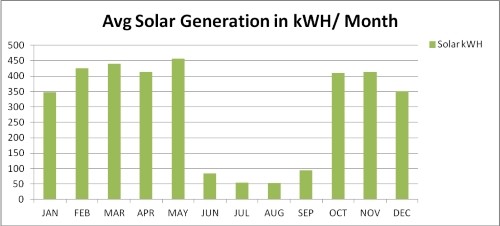Questions you may like to get answers for
Solar energy refers to the conversion of the sun’s rays into useful forms of energy, such as electricity or heat.

The solar radiation is amount of energy contained in sunlight falling on earth. It is measured in W/m2. Global solar radiation constant is 1300W/m2 and it is calculated by dividing the solar energy falling on earth by surface area of earth. The amount of solar radiation a location receives depends on a variety of factors:
Geographic location
Time of day
Season
Local landscape
Local weather
The Air Mass quantifies the reduction in the power of sun light as it passes through the atmosphere and is absorbed by air and dust. Technically, it is the path length which sun light takes through the atmosphere normalized to the shortest possible path length (that is, when the sun is directly overhead). Earth has Air Mass Index of 1.5 and hence the global solar radiation constant become 1000W/m2.
The Air Mass is defined as:
AM=1/cos θ
where θ is the angle from the vertical (zenith angle). When the sun is directly overhead, the Air Mass is 1. The air mass represents the proportion of atmosphere that the light must pass through before striking the Earth relative to its overhead path length, and is equal to Y/X.
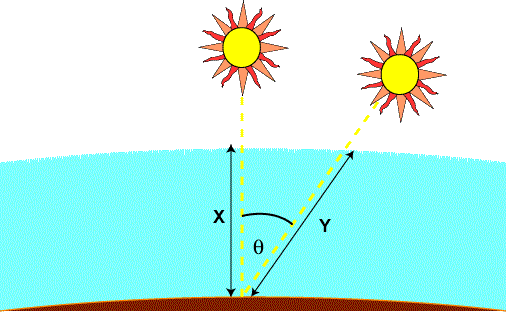
Because our location is near equator, we have excellent solar resources.
It is conversion of sun’s energy in light (photon) into electrons (direct current) using semiconductor device called solar module or panel. The solar panel is made of solar cells which are electrically connected with each other. Solar panel generates electricity in diffused light, fog, cloudy weather and rains at reduced output as compared to clear sunny day.
No, solar photovoltaic does not produce hot water. You need to install entirely different system called solar thermal collectors (flat copper plate/evacuated glass tube) to produce hot water.
There are 2 broad technologies: 1. Crystalline, 2. Thin Film, 3. Multi junction Concentrated PV
Crystalline solar panels are made of semiconductor grade silicon. The mono-crystalline solar cells has the continuous big crystal size with less number of grain boundaries as opposed to poly-crystalline or multi-crystalline which has the small crystals connected by large number of grain boundaries. This structural difference makes the mono-crystalline panel efficient and costly per unit of power than poly-crystalline. Commercially available solar panels have the efficiency from 12% to 24%.
Thin films are called so because the thickness of thin-film solar cell is comparative lesser than crystalline. They are made from Copper Indium Gallium Diselenide (CIGS), Cadmium Telluride (CdTe), Gallium Arsenide (GaAs), amorphous and other thin film silicon. Emerging third- generation thin-films are made of organic, polymer, quantum dot, dye-sensitized, copper zinc tin sulphide(CZTS) and perovskite materials. These type of solar cells are flexible and can be printed roll to roll and in any shape and color but it offers very low efficiency (below 5%). Commercially thin-film panels are available from efficiency of 1%to 20%.
It used lenses and curved mirror to focus sunlight onto small but highly efficient multi-junction solar cell. The multi junction (or tandem junction) solar cell is made by stacking the multiple types of P-N junction wafers on top of each other. CPV cost 3-4 times of same capacity c-Si or thin-film solar panels. It requires the concentrated sunlight to fall at exact 900 to CPV solar cell and it is achieved by the moving structure which tracks the sun on both axis (E-W & N-S).It does not produce any power The commercially available CPV are 35% efficient.
Thin-films give more (avg 5-8%) output than crystalline in both hot and cloudy weather which is typical of tropical region. The c-Si panels are costlier than thin films. But the power output degradation of c-Si (90% output at 10 years and 80% output at 25 years) is lot lesser than thin-film (75-80% output at 10 years and 50-60% output at 20 years).
Efficiency is ratio of solar energy falling on front surface to the generating area of solar panel ie. total solar cells’ area. 100Wp solar panel size is 1300mm x 650mm x 35mm and it has 1250mm x 560mm cell area. Hence 100Wp is generated by 1250mmx560mm cell area and thus it makes the 100Wp panel 14% efficient.
The open and empty area in square feet decides the solar capacity in Wp you can install. This area should be shadow free during entire year. It means you cannot install 100Wp panel if you do not have 1300mm x 650mm of empty, open and shadow free area! Next factor is your connected load that is power demand of all electrical appliances.
In AC circuits (utility supply or DG set), the Watt is obtained by multiplying voltage (V), current (I in Ampere) and power factor (pf) ie. W = V x I x pf. In DC circuits (battery), the Watt-dc is obtained by multiplying voltage (V), current (I in Ampere) ie. Wdc = V x I.
But in solar panel circuits, the Watt-peak is obtained by multiplying instantaneous maximum voltage (Vm), maximum current (Im in Ampere) during its operating period ie. Wp = Vm x Im.
Let us take an example of city of Aurangabad in Maharashtra, India where the solar modules should be mounted at 200 to the horizontal ground level.
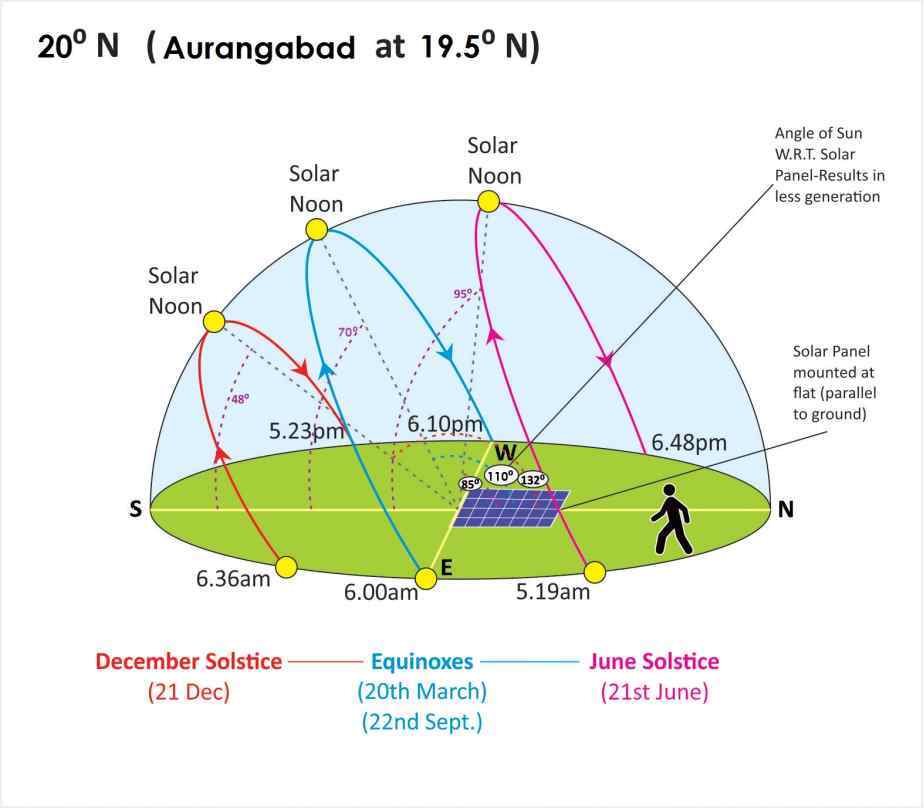
LESS GENERATION
1. Installation of Panel:
Flat (parallel to ground & not related to latitude of place)
2. Less capture of solar energy because the incidence of solar rays are at 1100 w.r.t. average position of sun in a year
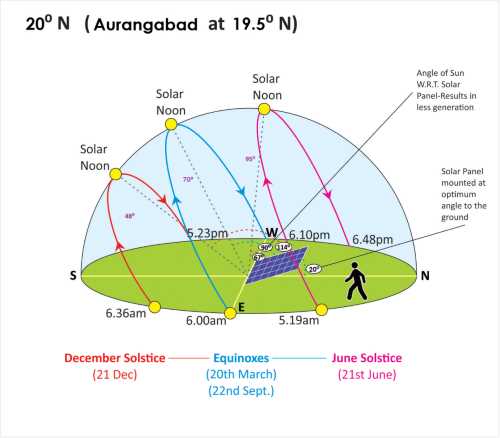 OPTIMUM GENERATION
OPTIMUM GENERATION
1. Installation of Panel:
200 to ground (At latitude angle of Aurangabad)
2. Optimum capture of solar energy because the incidence of solar rays are at 900 w.r.t. average position of sun in a year
16.1. On-grid/grid interactive/grid tied: solar system feed the electrical appliances and export the remaining power to utility supply grid during the sun hours. The utility power must be available to operate this type of system. The system shuts off during no utility supply / load shedding. There is no upper limit on the electrical load. But, there is mandatory lower limit on electrical load, for example, electrical load on the 1kWp grid tie system should not go below of 1kW during 9am to 5pm.
16.2. Off-grid: solar system charges and stores the power in battery and feed the electrical appliances through battery and inverter during sun hours as well as night if battery is not drained during the sun-hours. The system keeps operating during load shedding until battery is not drained. There is upper limit on electrical load, for example, electrical load on 1kWp off-grid system should not go above 0.85kW. But, there is no lower limit on electrical load.
16.3. Hybrid: solar system feeds the electrical appliances, charges the battery and feeds to the grid as well as synchronizes the system with diesel generator set according to preset conditions or automatically. The system is combination of on-grid and off-grid system and hence the name is Hybrid. The system keeps operating during load shedding until battery is not drained or online DG set is available.
Hybrid system is most suitable. Use on-grid if utility electricity supply is available all the time, you do not want to spend on batteries and do not have backup DG set.
Solar panel, panel mounting structure, grid interactive inverter, cables, electrical safety devices (fuses, mcbs, switches, etc) and equipments
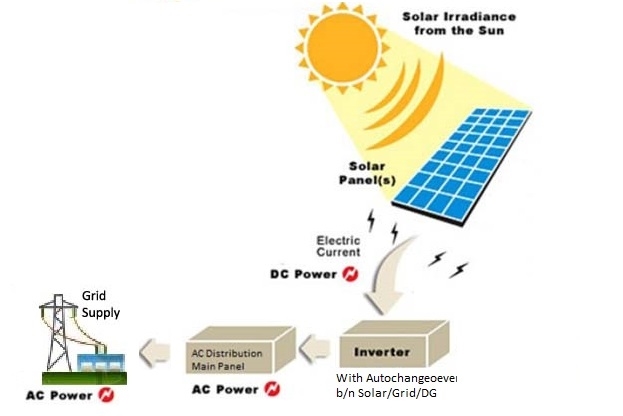
Solar panel, panel mounting structure, charge controller, battery, off grid inverter, cables, electrical safety devices (fuses, mcbs, switches, etc) and equipments.
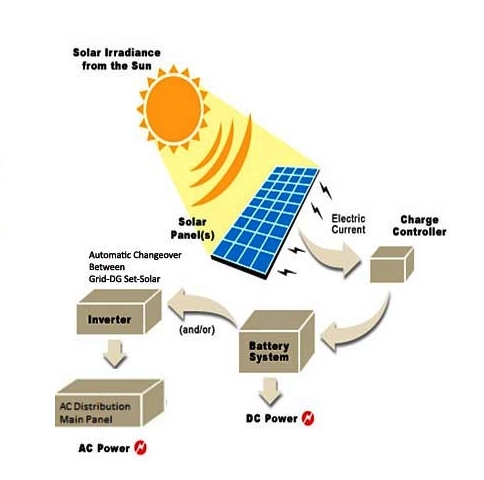
Solar panel, panel mounting structure, charge controller, battery, hybrid inverter, cables, electrical safety devices (fuses, mcbs, switches, etc), DG set if available and equipments.
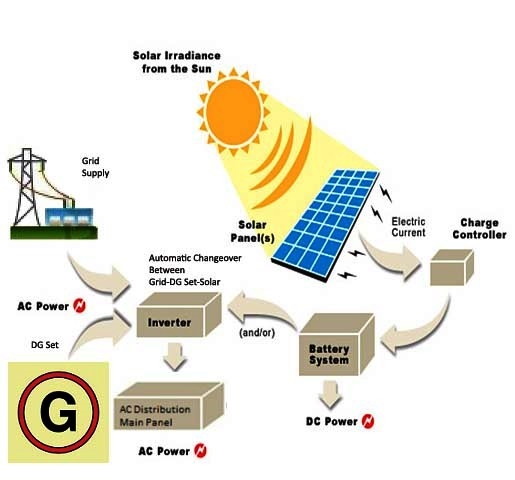
Balance of system consists of any component of solar system other then solar panel and inverter.
Yes, almost all the components except the mounting structures for your specific setup are easily available in market.
Even if Solar system has less number of components and it looks easy to assemble and connect it, the system will not perform at best or will not generate the maximum potential electricity in case all the components specifications are chosen carefully and matched to offer optimum performance. The installers are expert in understanding the detailed technical specifications and matching the parameters of components thereby offering optimum performance and generation at maximum potential.
1-10kWp: 1-3 weeks
10-50kWp: 3-8 weeks
50-100kWp: 8-12 weeks
100-500kWp: 12-20 weeks
500-1000kWp: 20-30 weeks
Upward of 1000kWp: 30-60 weeks
You can install the solar panels on raised structure at 8-10 ft height on roof or space and still utilize the space below it. But you may need to take permission from municipality and airport authority to install raised structure. If you are staying in housing society then you need to take permission of society before going ahead to municipality and airport authority.
Yes, you need a covered structure to keep inverter and battery to protect them from dust, rains and direct water contact.
As thumb rule, Solar panel generation (kWH) will be more or less than 4kWH per day and depends on your geographical location, clear sunny sky, dust, fog, soiling and temperature
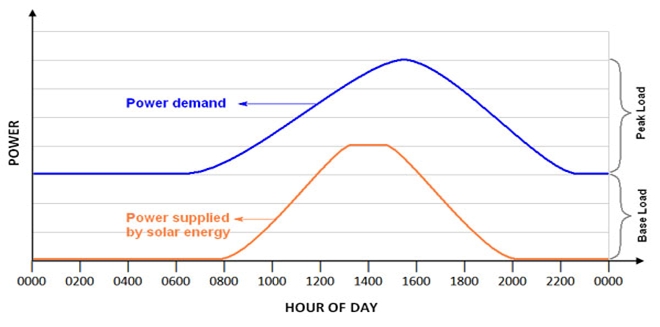
Yes, solar system will generate power but lower. During partial cloudy sky, generation will be 30-50% lower. During complete cloudy sky, generation will be 50-70% lower. During dark sky and rain, generation will be 70-90% lower. During very heavy rains, generation will be almost zero or 95% lower.
The solar modules are rated at laboratory based standard test conditions (S.T.C.). The 100Wp module will give maximum of 100W at 250C and 1000W/m2. But actual weather conditions and solar radiation is very different and fast changing than STC’s constant reference. In addition to this, there is power loss due to selective absorption of solar radiation, soiling loss ie deposition of dust and smog on panels, sudden variation in temperature, encapsulation (EVA) degradation. potential induces degradation due to leakage among solar cell, back-sheet, framing and mounting structure.
Every component in solar system adds some losses of its own to solar panel losses and hence the kWh output is less. . The on-grid system loses around 15%, off grid loses around 25% and hybrid loses around 15-25% depending on the mode it operates. Actual losses are manufacturer specific and dependent on the quality and efficiency of the component.
Warrantees are as follows- Solar panels: 20 to 25 years, inverter: 5 years, battery: 1 to 5 years, charger: 1to 5 years, mounting structure: 1 to 5 years, others: 1 to 2 years. Life of solar panel: beyond 25 years ie around 70-80% of the 1st year output at 25th year, inverter: 10 to 20 years, battery: 3 to 7 years, mounting structure: beyond 25 years, components other than fuses and mcbs: 5 to 25 years.
You can simply install DC meter before inverter and AC meter after the inverter and record the daily reading. Also, there are digital meters with communication capabilities which can store the reading in memory card as well as transfer to remotely connected computer and/or mobile over internet through cable or wireless medium.
There are following ways to buy solar power:
a. Pay total amount upfront & the system is yours
b. Part down payment and rest in pre-fixed installments over a period & either you own a system at the end of your last installment or supplier offer discount in fixed installment and take back system at the end of your last installment
c. Zero down payment and rest in pre-fixed installments over a period & either you own a system at the end of your last installment or supplier offer discount in fixed installment and take back system at the end of your last installment
d. Part down payment and rest in monthly installments based on pre-fixed tariff against actual kWH generated over a contract period (usually 10 to 25 years) & either you own a system at the end of your contract or supplier offer discounted tariff over a contract period and take back system at the end of contract
e. Part down payment and rest in EMI payments to bank
Don’t worry; you can still buy solar power in following ways:
1. Third party sale using Open Access: Open Access is the freedom given to consumers with connected load greater than 1 MW to choose their own supplier of power i.e., they are not restricted to buying power from the utility and can instead buy power from any 3rd party supplier of power. Therefore, the consumer can contract with a solar IPP to buy power generated from their solar PV plant. A consumer with connected load less than 1 MW may apply for open access; the utility is not obliged to grant open access in such cases, but may do so at its discretion.
Advantages
a. The consumer doesn’t have to invest in the power plant. The consumer only pays for the electricity supplied by the IPP
b. The consumer doesn’t need to maintain the power plant, or be concerned with warranties, quality of components, etc.
c. The consumer is no longer restricted by available rooftop space. The IPP’s solar plant may be much larger than what could have been installed on the consumer’s rooftop
d. Inter-state open access is not allowed. Power has to be procured only from power producers within the state
e. Open access charges in many states are very high
f. Cross subsidy charges are imposed on 3rd party sale
g. There are many delays in getting permissions
h. Congestion and transmission constraints may limit the amount of power that can be procured
Disadvantages
a. Due to the various charges and regulations involved in the procurement of power from 3rd party developers, we recommend a careful estimation of the landed cost (total cost to obtain the power at your distribution board) before deciding on procuring solar power from a 3rd party solar IPP.
2. Group Captive: Under the Group Captive scheme a group of persons/entities holding 26% shares in a RE generating company can each treat the power consumed as captive power provided they jointly consume more than 51% of the RE power generated.
Advantages
a. The consumer can gain economies of scale by investing jointly with other consumers in a very large plant
b. The consumers need to hold only 26% of the equity in the project. If the project is funded with 70% debt and only 30% equity, then the consumers need to jointly hold only 26% of 30% i.e., they invest only 7.8% in the cost of the project
c. Usually, a power plant developer builds the plant under a SPV company and offers 26% equity to the consumer(s). An agreement to buy back the shares on the termination of the procurement contract is also entered into
d. Cross-subsidy charges are not levied as the supplied power is treated as captive consumption
e. As part owners of the plant, consumers are eligible for Renewable Energy Certificates (RECs) and can further monetise Group captive arrangements through sale of RECs
f. Procuring power through group captive arrangements requires open access. Therefore group captive suffers from similar problems to 3rd party sale, such as high open access charges and obtaining permissions, though it does not attract cross-subsidy charges
g. Some organizations may not wish to hold equity in the SPV
Disadvantages
a. Both 3rd Party Sale and Group Captive mechanisms of procuring power utilise the grid infrastructure to deliver electricity from the power plant to the consumer. The supply of power is therefore affected by any event that affects the grid. Unless the consumer has a dedicated feeder, 3rd party and group captive power will not be supplied during load shedding or grid failure.
3. BOO(T) – Build Own Operate (Transfer):In the BOO(T) model, the rooftop system provider installs the plant on the consumer’s rooftop but only sells the power from the plant to the consumer. In this arrangement, the system provider would bear the capital expenditure for the solar unit provided the customer fulfils certain criteria and enters into a power purchase agreement (anywhere between 5-15 years) with the developer. If both parties agree, the ownership of the plant may be transferred to the consumer after a period of time.
Advantages
a. As the system is installed on the consumer’s rooftop, it does not use grid infrastructure to deliver power and is therefore not affected by grid outages or grid congestion
b. Open access is not required and open access charges do not apply as the plant is independent of the grid
c. The amount of power that can be procured is limited by the extent of roof space available for installing the plant
d. The rooftop system provider may require the consumer to have a good credit rating and/or provide payment security
e. The system provider is the owner of the plant and enjoys all incentives provided by the government, such as accelerated depreciation or RECs
Disadvantages
a. The amount of power that can be procured is limited by the extent of roof space available for installing the plant
b. The rooftop system provider may require the consumer to have a good credit rating and/or provide payment security
c. The system provider is the owner of the plant and enjoys all incentives provided by the government, such as accelerated depreciation or RECs
Illustration of charges applicable to each option
This table gives a comparison of the different charges that should be taken into account when calculating the landed cost of the procured power.
| Charges | 3rd Party Sale |
Group Captive |
BOO(T) |
|---|---|---|---|
Price of Power (at generation point) |
3.500 |
3.500 |
3.500 |
Electricity Duty |
0.000 |
0.000 |
Nil |
Electricity Tax |
0.000 |
0.000 |
Nil |
Line Loss |
0.100 |
0.100 |
Nil |
Transmission Charge |
0.090 |
0.090 |
Nil |
Wheeling Charge |
0.370 |
0.370 |
Nil |
Cross Subsidy Surcharge |
0.450 |
0.000 |
Nil |
Banking Charges |
0.04 |
0.094 |
0.094 |
Generation Tax |
0.100 |
0.100 |
0.000 |
Metering Charge |
0.250 |
0.250 |
0.000 |
Substation Maintenance Cost |
0.500 |
0.500 |
0.500 |
Effective Cost |
5.454 |
5.004 |
4.094 |
Note: The table is only meant to demonstrate how charges apply under different procurement. Source: solarmango
No, solar system complements DG set & reduce diesel consumption but cannot fully replace. Because DG set can be used as on demand and base backup power source 24x7 whereas solar power is available during the daytime on bright sunny day and solar output power changes every hour peaking at afternoon and very low in morning and evening, limited capacity of solar power cannot handle the heavy current demand by load in absence of fall back option of Utility supply. So it is advisable to integrate DG set with Solar system & operate both simultaneously. While integrating the DG set with solar power system, please do not forget that [A] DG do not operate below 30% of its rated capacity & hence keep the solar capacity below 70% of DG capacity. [B] Reverse current will flow into the diesel generator when the output of the solar power exceeds the load demand. Diesel generator trips beyond its acceptable current feeding limit, terminating the reference voltage for the on-grid solar system causing it to shut down. Even after considering all these factors, Solar PV lower the diesel consumption and substantially reduces the average generation cost from Rs. 16/kWh to Rs. 6/kWh, thereby makes the solar power an economically feasible option.
Still have questions?
No luck? contact us and we will respond soon
